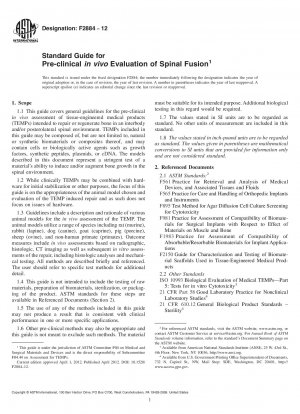ASTM F2884-12
Standard Guide for Pre-clinical in vivo Evaluation of Spinal Fusion
- Standard No.
- ASTM F2884-12
- Release Date
- 2012
- Published By
- American Society for Testing and Materials (ASTM)
- Status
- Replace By
- ASTM F2884-21
- Latest
- ASTM F2884-21
- Scope
This guide is aimed at providing a range of in vivo models to aid in preclinical research and development of tissue-engineered medical products (TEMPs) intended for the clinical repair or regeneration of bone in the spine.
This guide includes a description of the animal models, surgical considerations, and tissue processing as well as the qualitative and quantitative analysis of tissue specimens.
The user is encouraged to utilize appropriate ASTM and other guidelines to conduct cytotoxicity and biocompatibility tests on materials, TEMPs, or both, prior to assessment of the in vivo models described herein.
It is recommended that safety testing be in accordance with the provisions of the FDA Good Laboratory Practices Regulations 21 CFR 58.
Safety and effectiveness studies to support regulatory submissions (for example, Investigational Device Exemption (IDE), Premarket Approval (PMA), 510K, Investigational New Drug (IND), or Biologics License Application (BLA) submissions in the U.S.) should conform to appropriate guidelines of the regulatory bodies for development of medical devices, biologics, or drugs.
Animal model outcomes are not necessarily predictive of human results and should, therefore, be interpreted cautiously with respect to potential applicability to human conditions.
1.1 This guide covers general guidelines for the pre-clinical in vivo assessment of tissue-engineered medical products (TEMPs) intended to repair or regenerate bone in an interbody and/or posterolateral spinal environment. TEMPs included in this guide may be composed of, but are not limited to, natural or synthetic biomaterials or composites thereof, and may contain cells or biologically active agents such as growth factors, synthetic peptides, plasmids, or cDNA. The models described in this document represent a stringent test of a material’s ability to induce and/or augment bone growth in the spinal environment.
1.2 While clinically TEMPs may be combined with hardware for initial stabilization or other purposes, the focus of this guide is on the appropriateness of the animal model chosen and evaluation of the TEMP induced repair and as such does not focus on issues of hardware.
1.3 Guidelines include a description and rationale of various animal models for the in vivo assessment of the TEMP. The animal models utilize a range of species including rat (murine), rabbit (lapine), dog (canine), goat (caprine), pig (porcine), sheep (ovine), and non-human primate (primates). Outcome measures include in vivo assessments based on radiographic, histologic, CT imaging as well as subsequent in vitro assessments of the repair, including histologic analyses and mechanical testing. All methods are described briefly and referenced. The user should refer to specific test methods for additional detail.
1.4 This guide is not intended to include the testing of raw materials, preparation of biomaterials, sterilization, or packaging of the product. ASTM standards for these steps are available in Referenced Documents (Section 2).
1.5 The use of any of the methods included in this guide may not produce a result that is consistent with clinical performance in one or more specific applications.
1.6 Other pre-clinical methods may also be appropriate and this guide is not meant to exclude such methods. The material must be suitable for its intended purpose. Additional biological testing in this regard would be required.
1.7 The values stated in SI units are to be regarded as standard. No other units of measurement are included in this standard.
1.8 The values state......
ASTM F2884-12 Referenced Document
- ASTM F1983 Standard Practice for Assessment of Compatibility of Absorbable/Resorbable Biomaterials for Implant Applications
- ASTM F2150 Standard Guide for Characterization and Testing of Biomaterial Scaffolds Used in Regenerative Medicine and Tissue-Engineered Medical Products
- ASTM F561 Practice for Retrieval and Analysis of Implanted Medical Devices, and Associated Tissues
- ASTM F565 Standard Practice for Care and Handling of Orthopedic Implants and Instruments
- ASTM F895 Standard Test Method for Agar Diffusion Cell Culture Screening for Cytotoxicity
- ASTM F981 Standard Practice for Assessment of Compatibility of Biomaterials for Surgical Implants with Respect to Effect of Materials on Muscle and Bone
- ISO 10993 Biological evaluation of medical devices — Part 9: Framework for identification and quantification of potential degradation products
ASTM F2884-12 history
- 2021 ASTM F2884-21 Standard Guide for Pre-clinical
in vivo Evaluation of Spinal Fusion - 2012 ASTM F2884-12 Standard Guide for Pre-clinical
in vivo Evaluation of Spinal Fusion
